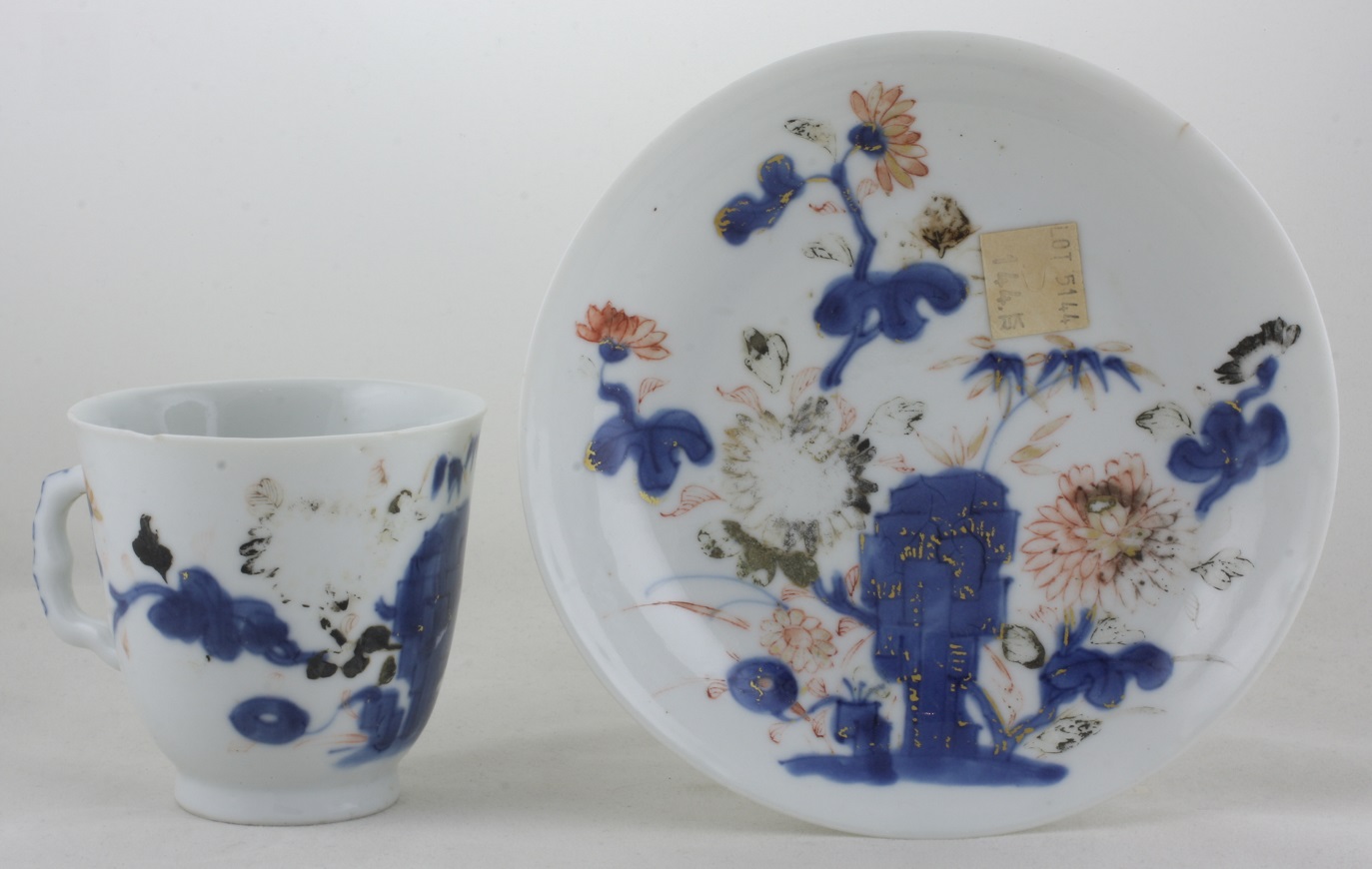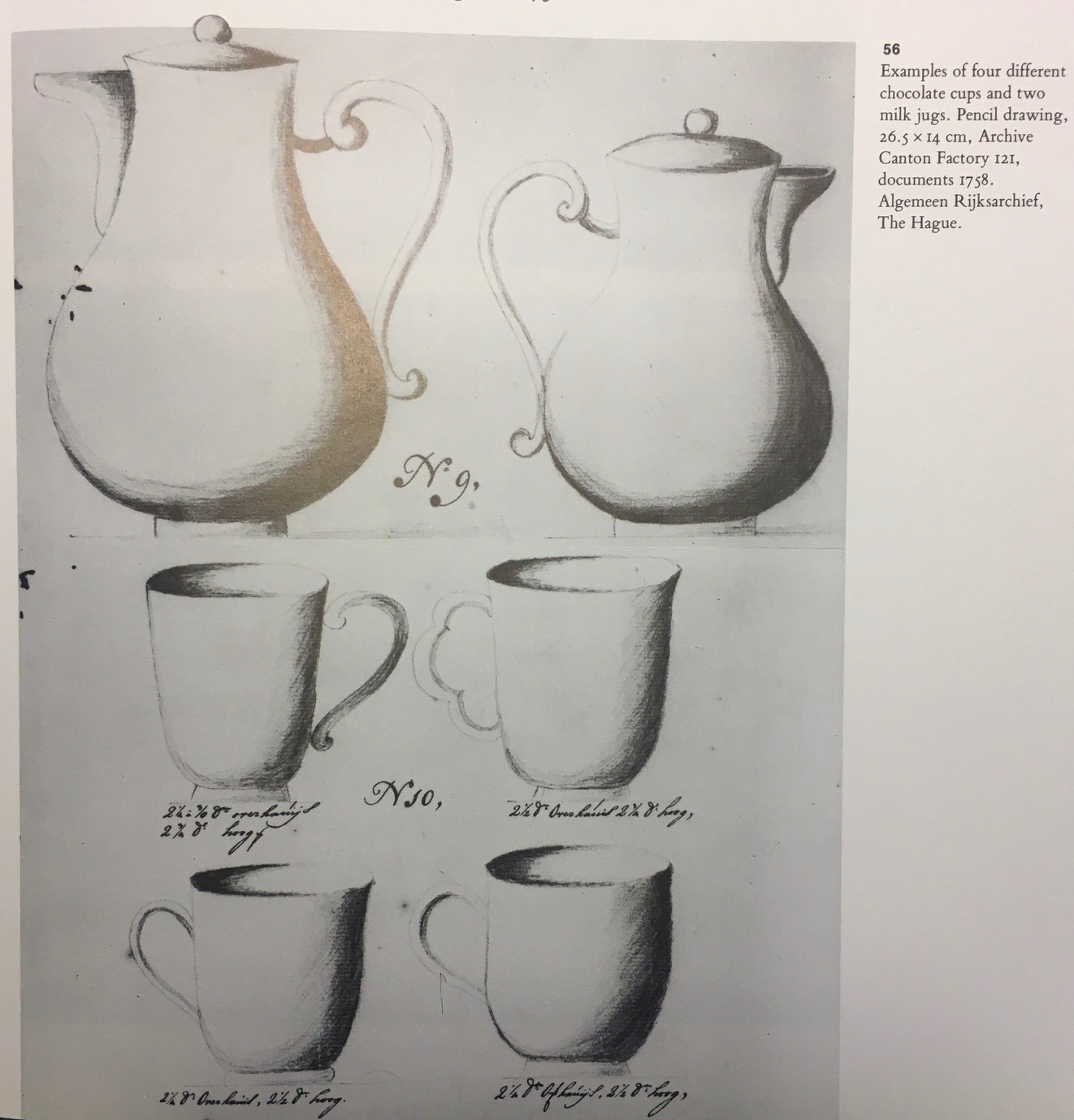
Sold Ceramics - Sold Shipwreck Porcelains - The Nanking Cargo, 1752 - Tea, Coffee and Chocolate wares - Page 1
Object 2012329
A chocolate cup and saucer
China
c.1751
Provenance: The Nanking Cargo sale, Christie's Amsterdam, 28 April - 2 May 1986
Height of cup 69 mm (2.72 inch), diameter of rim 73 mm (2.87 inch), diameter of footring 35 mm (1.38 inch), weight 99 grams (3.49 ounce (oz.))
Height of saucer 25 mm (0.98 inch), diameter of rim 133 mm (5.24 inch), diameter of footring 78 mm (3.07 inch), weight 98 grams (3.46 ounce (oz.))
A chocolate cup and saucer on footrings, straight sides, slightly everted rim and scalloped handles. Chinese Imari, decorated in underglaze blue, overglaze iron-red and gold with the "Chrysanthemum Rock" pattern in blue and enamels. Painted with chrysanthemum, bamboo and daisy issuing around a jagged outcrop of rockwork, the tall tapering cup with elaborate scalloped loop handle of European inspiration. Inside the cup and in the centre of the saucer the original rectangular paper Christie's lot 5144/144 label. On the bases of both the cup and the saucer the original circular paper Christie's The Nanking Cargo sale lot 5144 labels proving they have been one of 144 similar chocolate cups and saucers sold in lot 5144. (Amsterdam 1986, p.235)
On Monday January 3, 1752, the Dutch East India Company, (Vereenigde Oost-Indische Compagnie, VOC) ship Geldermalsen, struck a reef on her return journey to the Netherlands and sank in the South China Sea. Of the crew 32 survived and 80 went down with the ship and her cargo of tea, raw silk, textiles, dried wares, groceries, lacquer and porcelain.
The cargo of Chinese porcelain was originally potted in Jingdezhen, Jiangzi province then shipped to Nanking for delivery to the VOC vessel Geldermalsen for final transportation to the Netherlands. The Geldermalsen struck a reef on her return journey to the Netherlands and sank in the South China Sea on January 3, 1752. The cargo was recovered by Captain Michael Hatcher and his team in 1985 and sold by Christie's Amsterdam on 28 April - 2 May 1985 as 'The Nanking Cargo. Chinese Export Porcelain and Gold' two hundred and thirty-five years later. (Jörg 1986/1. pp.39-59).
An interesting detail is that Captain Michael Hatcher found the wreck of the Geldermalsen on the same reef as he earlier, in 1983, found the wreck of a Chinese junk. both wrecks were about a mile apart. This Chinese Junk wreck came to be known as "The Hatcher Junk" she had a cargo of Kraak and Transitional porcelain objects that were dated c.1643. (Sheaf & Kilburn 1988, p.27)
In the auction catalogue 'The Nanking Cargo, Chinese Export porcelain and Gold', Christie's Amsterdam describes these chocolate cups as teacups.
Jörg states that in orders, shipping invoices and unpacking books from this period two types of chocolate cups and saucers are mentioned: with and without handles. The order for 1761 gives an exact description of such a cup: 70 mm (2.76 inch) high, with straight sides slightly sloping outwards and a diameter equal to its height. We even have a drawing of such a chocolate cup, part of the order made up in 1759. It looks exactly like the cups with scalloped handles found in the wreck. There is no question but that these are indeed chocolate cups. The same decoration of large flowers and bamboo near a rock is executed both in underglaze blue and Imari, as well in enamel colours. In all, 9,735 cups and saucers for chocolate had been bought in Canton. They also included enamelled high cups with round handles, which are indicated as a type in the drawing of 1758 too. Hatcher has recovered 2,263 pairs of chocolate cups and saucers with scalloped handles and 1.996 pairs with round handless. Apparently there were no chocolate cups without handle bought in 1751. (Jörg 1986/1, pp. 68-69)
Cups of this shape, which always have a handle, are usually called coffee cups, but in fact are chocolate cups. This is made clear from the numerous references and descriptions of "chocolate cups with handles" in the records of the Dutch East India Company (VOC). Orders state that "the cups must be straight without overhanging rims", the cup narrower inside. An average height of 70 mm is given and is stressed that the diameter of the rim should be equal to the height. Drawn models of 1758 which have fortunately been preserved, show four cups of this shape with different handles, which are specified as "chocolate cups" in the description. Large tea, coffee and chocolate services always included this type of cup, but they could be bought separately as well. Enamelled cups and saucers were bought by the Company for around 20 cents and sold in the Netherlands for around 50 cents apiece. (Jörg & Van Campen 1997, p.215)

(Reproduced from; The Geldermalsen. History and Porcelain, (C.J.A. Jörg, Groningen 1986), p.69, fig. 56.)
The design on these chocolate cups is known as the 'Chrysanthemum Rock' pattern in blue and enamels. In total 1,469 chocolate cups and saucers with the 'Chrysanthemum Rock' pattern in blue and enamels, were sold divided over the lots: 5139-5151 (Amsterdam 1986)
For a sold chocolate cup decorated the 'Chrysanthemum Rock' pattern in enamels, please see:
Condition:
Cup: Two fleabites and a chip tpo the rim.
Saucer: A short hairline to the rim.
References:
Jörg 1986/1, pp.39-59 & fig. 54, 55 & 56
Sheaf & Kilburn 1988, p.27 & Pl.146
Jörg & Van Campen 1997, cat. 240
Price: Sold.


 create websites
create websites